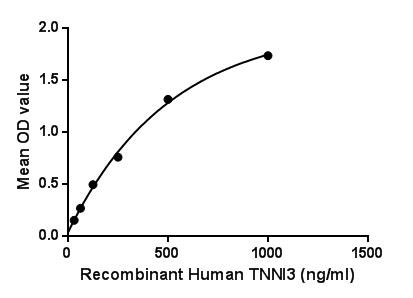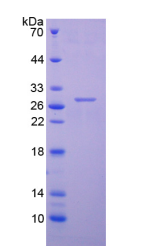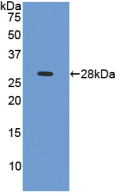Active Cardiac Troponin I (cTnI) 

TNNI3; TNNC1; CMH7; C-TnI; Troponin I Type 3; Troponin I Type 3, Cardiac
- UOM
- FOB US$ 252.00 US$ 630.00 US$ 1,260.00 US$ 3,780.00 US$ 9,450.00
- Quantity
Overview
Properties
- Product No.APA478Hu01
- Organism SpeciesHomo sapiens (Human) Same name, Different species.
- ApplicationsCell culture; Activity Assays.
Research use only - DownloadInstruction Manual
- CategoryCardiovascular biology
- Buffer Formulation20mM Tris, 150mM NaCl, pH8.0, containing 1mM EDTA, 1mM DTT, 0.01% SKL, 5% Trehalose and Proclin300.
- Traits Freeze-dried powder, Purity > 97%
- Isoelectric Point9.7
Sign into your account
Share a new citation as an author
Upload your experimental result
Review

Contact us
Please fill in the blank.
Activity test

Figure. The binding activity of TNNI3 with TNNT2.
Troponin I Type 3, Cardiac (TNNI3) is a protein that in humans is encoded by the TNNI3 gene. It is a tissue-specific subtype of troponin I, which in turn is a part of the troponin complex. The TNNI3 gene encoding cardiac troponin I (cTnI) is located at 19q13.4 in the human chromosomal genome. Human cTnI is a 24kDa protein consisting of 210 amino acids with isoelectric point (pI) of 9.87. cTnI is exclusively expressed in adult cardiac muscle. Besides, Troponin T Type 2, Cardiac (TNNT2) has been identified as an interactor of TNNI3, thus a binding ELISA assay was conducted to detect the interaction of recombinant human TNNI3 and recombinant human TNNT2. Briefly, TNNI3 was diluted serially in PBS with 0.01% BSA (pH 7.4). Duplicate samples of 100μL were then transferred to TNNT2-coated microtiter wells and incubated for 2h at 37℃. Wells were washed with PBST and incubated for 1h with anti-TNNI3 pAb, then aspirated and washed 3 times. After incubation with HRP labelled secondary antibody, wells were aspirated and washed 3 times. With the addition of substrate solution, wells were incubated 15-25 minutes at 37℃. Finally, add 50µL stop solution to the wells and read at 450nm immediately. The binding activity of TNNI3 and TNNT2 was shown in Figure 1, and this effect was in a dose dependent manner.
Usage
Reconstitute in 20mM Tris, 150mM NaCl (pH8.0) to a concentration of 0.1-1.0 mg/mL. Do not vortex.
Storage
Avoid repeated freeze/thaw cycles. Store at 2-8°C for one month. Aliquot and store at -80°C for 12 months.
Stability
The thermal stability is described by the loss rate. The loss rate was determined by accelerated thermal degradation test, that is, incubate the protein at 37°C for 48h, and no obvious degradation and precipitation were observed. The loss rate is less than 5% within the expiration date under appropriate storage condition.
Increment services
-
 BCA Protein Quantification Kit
BCA Protein Quantification Kit
-
 Molecular Mass Marker for Protein
Molecular Mass Marker for Protein
-
 Monoclonal Antibody Customized Service
Monoclonal Antibody Customized Service
-
 Polyclonal Antibody Customized Service
Polyclonal Antibody Customized Service
-
 Protein Activity Test Experiment Service
Protein Activity Test Experiment Service
-
 Electrophoretic Mobility Shift Assay (EMSA) Experiment Service
Electrophoretic Mobility Shift Assay (EMSA) Experiment Service
-
 Buffer
Buffer
-
 Lentivirus Packaging Experiment Service
Lentivirus Packaging Experiment Service
-
 Adenovirus Packaging Experiment Service
Adenovirus Packaging Experiment Service
-
 Real Time PCR Experimental Service
Real Time PCR Experimental Service
-
 Spike RBD Protein (S-RBD)
Spike RBD Protein (S-RBD)
-
 Protein G
Protein G
-
 Protein A
Protein A
Citations
- The effects of caloric restriction and age on thyroid hormone signalling in the heart of ratsPl:Source
- Comparison of femoral and aortic remote ischaemia preconditioning for cardioprotection against myocardial ischaemia/reperfusion injury in a rat modelPubmed:25205781
- Cardioprotective effect of remote preconditioning of trauma and remote ischemia preconditioning in a rat model of myocardial ischemia/reperfusion injuryPubMed: 26136887
- Circulating miR-126 and miR-499 reflect progression of cardiovascular disease; correlations with uric acid and ejection fractionpubmed:27924211
- Cardiac biomarkers in dogs with visceral leishmaniasisS0301-732X2016000300004
- Cathepsin B aggravates coxsackievirus B3-induced myocarditis through activating the inflammasome and promoting pyroptosisPubmed:29360865
- Co-exposure of silica nanoparticles and methylmercury induced cardiac toxicity andPubmed:29727991
- Melatonin balance the autophagy and apoptosis by regulating UCP2 in the LPS-induced cardiomyopathyPubmed:29547569
- The Multivariate Regression Statistics Strategy to Investigate Content-Effect Correlation of Multiple Components in Traditional Chinese Medicine Based on a …Pubmed:29494523
- Protective effects of N (2)‑L‑alanyl‑L‑glutamine mediated by the JAK2/STAT3 signaling pathway on myocardial ischemia reperfusionPubmed:29393473
- Hydrogen‑rich solution against myocardial injury and aquaporin expression via the PI3K/Akt signaling pathway during cardiopulmonary bypass in ratsPubmed:29956781
- Protective Effects of Shenfu Injection against Myocardial Ischemia-Reperfusion Injury via Activation of eNOS in RatsPubmed:29910216
- Hydrogen‑rich solution attenuates myocardial injury caused by cardiopulmonary bypass in rats via the Janus‑activated kinase 2/signal transducer and activator of …Pubmed:29928398
- Enoxaparin attenuates doxorubicin induced cardiotoxicity in rats via interfering with oxidative stress, inflammation and apoptosisPubmed:29321061
- Signature-oriented investigation of the efficacy of multicomponent drugs against heart failurePubmed: 30230922
- Trimetazidine Attenuates Exhaustive Exercise-Induced Myocardial Injury in Rats via Regulation of the Nrf2/NF-κB Signaling PathwayPubmed: 30890937
- Could cardioprotective effect of ACE2 activator “diminazene aceturate” is more potent than ACE inhibitor “Enalapril” on acute myocardial infarction in rats?Pubmed: 30840489
- Inflammatory cytokines associated with cancer growth induce mitochondria and cytoskeleton alterations in cardiomyocytesPubmed: 30982981
- Electrochemical dual-aptamer-based biosensor for nonenzymatic detection of cardiac troponin I by nanohybrid electrocatalysts labeling combined with DNA …Pubmed: 30954926
- Protective effects of two novel nitronyl nitroxide radicals on heart failure induced by hypobaric hypoxiaPubmed: 31102744
- DNA nanotetrahedron linked dual-aptamer based voltammetric aptasensor for cardiac troponin I using a magnetic metal-organic framework as a labelPubmed: 31123904
- DNA nanotetrahedron-assisted electrochemical aptasensor for cardiac troponin I detection based on the co-catalysis of hybrid nanozyme, natural enzyme and artificial …
- MiR‐183‐5p protects rat hearts against myocardial ischemia/reperfusion injury through targeting VDAC1Pubmed: 31618500
- Red blood cell-derived semaphorin 7A promotes thrombo-inflammation in myocardial ischemia-reperfusion injury through platelet GPIbPubmed: 32161256
- Chlorogenic acid prevents acute myocardial infarction in rats by reducing inflammatory damage and oxidative stressPubmed: 33022535
- Therapeutic potential of cPLA2 inhibitor to counteract dilated-cardiomyopathy in cholesterol-treated H9C2 cardiomyocyte and MUNO ratPubmed: 32942017
- Early Elevation of Systemic Plasma Clusterin after Reperfused Acute Myocardial Infarction in a Preclinical Porcine Model of Ischemic Heart DiseasePubmed: 32605184
- NLRX1 knockout aggravates lipopolysaccharide (LPS)-induced heart injury and attenuates the anti-LPS cardioprotective effect of CYP2J2/11, 12-EET by enhancing …Pubmed: 32574674
- Inhibition of calpain alleviates coxsackievirus B3-induced myocarditis through suppressing the canonical NLRP3 inflammasome/caspase-1-mediated and …Pubmed: 32509190
- Ethanolic and Aqueous Extracts of Avocado (Persea americana) Seeds Attenuates Doxorubicin-Induced Cardiotoxicity in Male Albino Rats
- Early label-free analysis of mitochondrial redox states by Raman spectroscopy predicts septic outcomes
- Alamandine significantly reduces doxorubicin-induced cardiotoxicity in rats33882726
- Isolation and Culture of Neonatal Murine Primary Cardiomyocytes34289259
- Pharmacological inhibition of arachidonate 12-lipoxygenase ameliorates myocardial ischemia-reperfusion injury in multiple species34536344
- Pea (Pisum sativum) peel extract attenuates DOX-induced oxidative myocardial injury34649330
- Development of a novel ssDNA aptamer targeting cardiac troponin I and its clinical applications34673993
- Nicotinic Acid Riboside Regulates Nrf-2/P62-Related Oxidative Stress and Autophagy to Attenuate Doxorubicin-Induced Cardiomyocyte InjuryPubmed:35242876
- A rapid fluorescent aptasensor for point-of-care detection of C-reactive proteinPubmed:35714415
- Mokko Lactone Alleviates Doxorubicin-Induced Cardiotoxicity in Rats via Antioxidant, Anti-Inflammatory, and Antiapoptotic Activities. Nutrients 2022, 14, 733Pubmed:35215383








